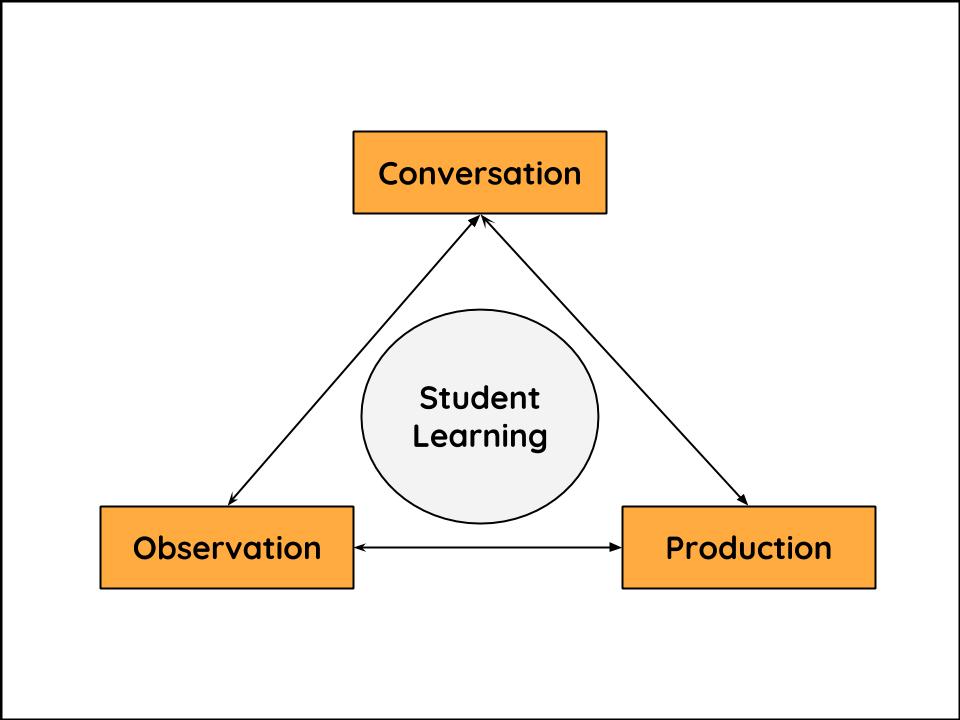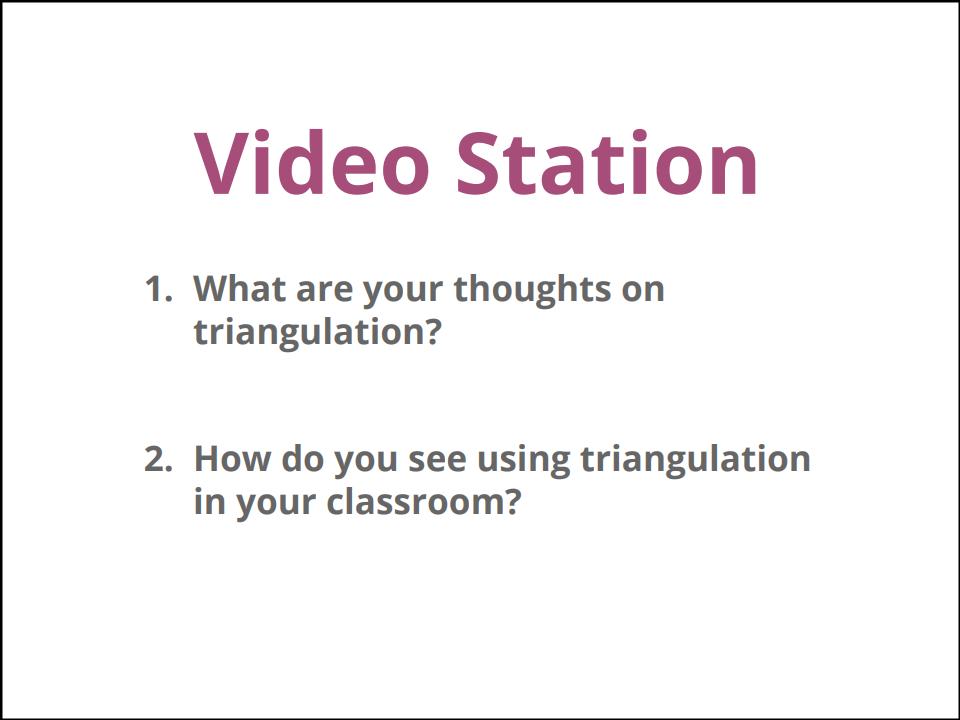Questions for Reflection:
Do you assess your students in more than one way?
Why would we want to assess our students in more than one way?
Main ideas:
- Triangulation is a way to gather evidence about student learning in three ways – through observation, conversation, and product.

- The idea is to not only gather the evidence but to compare the evidence against each other in order to construct a clearer portrait of student learning.
- When we gather evidence of learning in this way, it happens over time – not all at once.
Activity: Video viewing + initial reflection
The following video is a conversation between Avi Spector, Gail Gagnon, and Tracy Rosen about triangulation. We created it for a province-wide professional development day in February, 2016 about gathering evidence of student learning. The PD was delivered using a station-rotation model, so that participants could talk to each about new concepts in small groups.
—> Here are the reflection questions that were used by some for journaling, by others as conversation starters at the station about Triangulation during that PD day. It was our way of structuring the viewing of this video at the station.

Why would we want to use triangulation in adult education?
By gathering evidence of what our learners know, understand, and can do, we are better able to design learning situations that support them in the development of the competencies they need to succeed in our courses. This is true for every level of learning and what makes it more poignant for adult education is that the final evaluation is worth 100% of their marks. This is a high-stakes test! Here are some additional factors:
- There are a limited number of versions of the exams so when a learner is writing we want to make sure they will not need to re-write. We may not like to focus on this but it is a logistical reality.
- Most importantly we want our learners to succeed when they write their exams – triangulation can ensure that we know exactly where our students are in their learning so we will know when they are ready to write (and have evidence to back that up!)
- Even stronger, once we have started to keep track of our students’ learning like this, it makes it easier to share the evidence of their learning with them so that they know where they are and what they need to do to keep growing in their learning.
So how do we get started with triangulation?
As Troy says in this short video, most of us are already doing at least one of the elements: observing students as they learn, having conversations with them about their learning, and/or analyzing the products they create.
Triangulation is a model to help formalize the process across all three elements in order to generate tangible evidence of student learning that can be compared against each other.
As Troy suggests – starting small is smart. It is a process, not an event!
A good way to begin is by keeping track of the ways you already assess student learning in your courses and then adding one more way to assess. Many of the teachers who have already gone through this activity realized that their assessment practice was heavy on product, so they decided to gradually add different kinds of assessment through conversation and/or observation to balance things out.
Triangulation in Action
Here are some ways that teachers are using conversation, observation, and production assessment strategies in the classroom.
Conversation: student/teacher conferences, portfolios, guided conversations, exit slips, journaling, commenting on online documents, email …
Using a stoplight strategy as a way to gather information through exit cards
Observation: checklists, running records, video of collaborative group work, anecdotal records, picture taking…
Using mailing labels to organize observations
Question: How would you record what you observe in this math class?
Production: performance tasks, quizzes, projects, videos, presentations…
A strategy to assess writing products
Using student product for immediate clarification of concepts
Valuing Professional Judgment
A big piece of assessing learning in different ways is valuing your own professional judgment. Often, we tend to value products (like quizzes) over our own conversations with and observations of students so our assessment practice becomes skewed toward product. Balancing things can help to shift our values and validate our own professional judgement in the assessment process.
Planning for Triangulation
The document Planning for Triangulation can help you with this. It includes an overview of a triangulation model, examples of different assessment strategies, weak and strong triangulation plans, as well as empty templates for you to use in your own planning.
If you use Google, make a copy of the document located here and add it to your Drive (you will need to be logged in to see it):
—> If you prefer, here is a link to a pdf copy of Planning for Triangulation.
Interested in learning more?
Speak with your pedagogical consultant: Many of the pedagogical consultants in the nine English school board adult education sectors are involved in a project to develop a culture of formative assessment in our centres.
Contact Tracy Rosen or Avi Spector
Extension Resources
Learning resources created and compiled by Troy Bradley (Teacher, LBPSB), Gail Gagnon (Consultant, LBPSB), Shanna Loach (Consultant and Teacher, ETSB), Isa Helfield (Consultant, EMSB), Avi Spector (RECIT Consultant, RSB), and Tracy Rosen (RECIT Consultant, CSSMI), 2016.
All materials are expected to be reused and shared according to this Creative Commons license: CC BY-NC-SA 4.0
